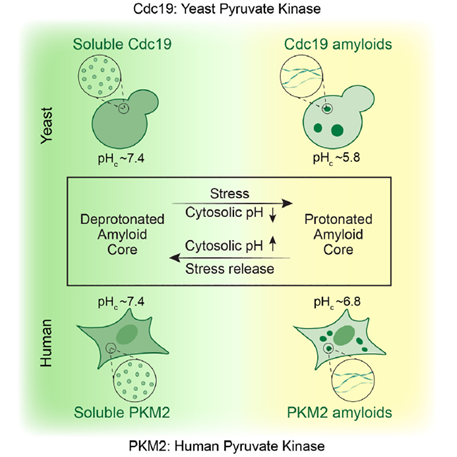An evolutionarily conserved mechanism controls reversible amyloids via pH-sensing regions
A recent “Developmental Cell” paper by the Peter group (IBC), in collaboration with the Riek, Arosio, Mezzenga (ETH), and Knowles (Cambridge) groups, reveals an evolutionarily conserved mechanism that regulates amyloid formation and disassembly, profoundly affecting cellular metabolism and growth.

Amyloids are typically known as irreversible clumps of proteins linked to diseases like Alzheimer's and Parkinson’s. However, previous work in the Peter Lab (Saad et al., 2017; Cereghetti et al., 2021) showed that certain amyloids can assemble, and dissolve as needed, playing important physiological roles. Yet, the differences between functional and pathological amyloids, and the molecular mechanisms controlling their formation an d dissolution, remained poorly understood.
Now, a new study from the Peter lab at the Institute of Biochemistry (IBC) identified an evolutionarily conserved mechanism regulating reversible amyloid formation of the essential metabolic enzyme pyruvate kinase (PK). The study shows that both yeast (Cdc19) and human (PKM2) PK can form and dissolve amyloids in response to physiological pH changes. Under stress, cells become more acidic, causing PK to stack together triggered by a key motif, termed “amyloid cores”. This sequence directly senses pH changes via specific amino acids (glutamate in yeast and histidine in humans), which get protonated in acidic conditions. Importantly, reversible PK amyloids help cells managing stress conditions by shutting down key metabolic processes and protecting PK from degradation. Together these findings suggest that pH-sensitive amyloid formation is an ancient and widespread stress response mechanism coupling metabolism and cell survival.
Link to the paper in external page “Developmental Cell”.